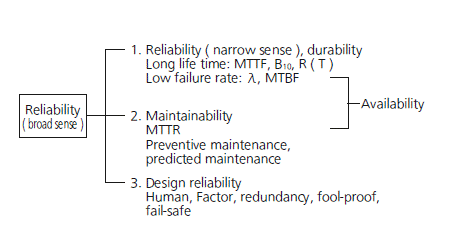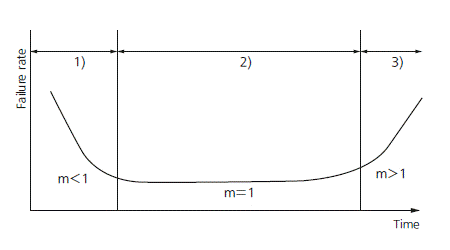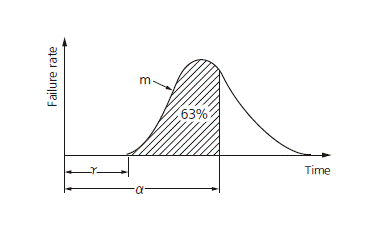Here is PDF of this page.
1. About Reliability
Reliability in a Narrow Sense of the Term
In the industrial space, reliability is a measure of how long a particular product operates without failure.
Reliability in a Broad Sense of the Term
Every product has a finite service lifetime. This means that no product can continue normal service infinitely. When a product has broken down, the user may throw it away or repair it. The reliability of repairable products is recognized as "reliability in a broad sense of the term".
For repairable products, their serviceability or maintainability is another problem. In addition, reliability of product design is becoming a serious concern for the manufacturing industry. In short, reliability has three senses: i.e. reliability of the product itself, serviceability of the product, and reliability of product design.

Intrinsic Reliability and Reliability of Use
Reliability is "built" into products. This is referred to as intrinsic reliability which consists mainly of reliability in the narrow sense.
Product reliability at the user's site is called "reliability of use", which consists mainly of reliability in the broad sense.
In the relay industry, reliability of use has a significance in aspects of servicing.
2. Reliability Measures
The following list contains some of the most popular reliability measures:
| Reliability measure | Sample representation |
|---|
| Degree of reliability R (T) | 99.9% |
|---|
| MTBF | 100 hours |
|---|
| MTTF | 100 hours |
|---|
| Failure rate λ | 20 Fit, 1%/hour |
|---|
| Safe life B10 | 50 hours |
|---|
Degree of Reliability
Degree of reliability represents percentage ratio of reliability. For example, if none of 10 light bulbs has failed for 100 hours, the degree of reliability defined in, 100 hours of time is 10/10 = 100%. If only three bulbs remained alive, the degree of reliability is 3/10 = 30%.
The JIS Z8115 standard defines the degree of reliability as follows:
The probability at which a system, equipment, or part provides the specified functions over the intended duration under the specified conditions.
MTBF
MTBF is an acronym of mean time between failures.
It indicates the mean time period in which a system, equipment, or part operates normally between two incidences of repair.
MTBF only applies to repairable products.
MTBF tells how long a product can be used without the need for repair.
Sometimes MTBF is used to represent the service lifetime before failure.
MTTF
MTTF is an acronym of mean time to failure.
It indicates the mean time period until a product becomes faulty MTTF normally applies to unrepairable products such as parts and materials.
The relay is one of such objective of MTTF.
Failure Rate
Failure rate includes mean failure rate and momentary failure rate.
Mean failure rate is defined as follows:
Mean failure rate = Total failure count/total operating hours
In general, failure rate refers to momentary failure rate. This represents the probability at which a system, equipment, or part, which has continued normal operation to a certain point of time, becomes faulty in the subsequent specified time period.
Failure rate is often represented in the unit of percent/hours. For parts with low failure rates,
"failure unit (Fit) = 10-9/hour"
is often used instead of failure rate.
Percent/count is normally used for relays.
Safe Life
Safe life is an inverse of degree of reliability.
It is given as value B which makes the following equation true:
1 - R (B) = t%
In general, "B [1 - R (B)] = 10%" is more often used.
In some cases this represents a more practical value of reliability than MTTF.
3. Failure
What is Failure?
Failure is defined as a state of system, equipment, or component in which part of all of its functions are impaired or lost.
Bathtub Curve
Product's failure rate throughout its lifetime is depicted as a bathtub curve, as shown below. Failure rate is high at the beginning and end of its service lifetime.
The high failure rate in the initial failure period is derived from latent design errors, process errors, and many other causes. Initial failures are screened at manufacturer's site through burn-in process. This process is called debugging, performing aging or screening.
- Accidental failure period
The initial failure period is followed by a long period with low, stable failure rate. In this period, called accidental failure period, failures occurs at random along the time axis. While zero accidental failure rate is desirable, this is actually not practical in the real world.
In the final stage of the product's service lifetime comes the wear-out failure period, in which the life of the product expires due to wear of fatigue. Preventive maintenance is effective for this type of failure. The timing of a relay's wear-out failure can be predicted with a certain accuracy from the past record of uses. The use of a relay is intended only in the accidental failure period, and this period virtually represents the service lifetime of the relay.

Weibull Analysis
Weibull analysis is often used for classifying a product's failure patterns and to determine its lifetime.
Weibull distribution is expressed by the following equation:

m: Figure parameter
α: Measurement parameter
γ : Position parameter
Weibull distribution can be adopted to the actual failure rate distribution if the three variables above are estimated.

The Weibull probability chart is a simpler alternative of complex calculation formulas. The chart provides the following advantages:
- The Weibull distribution has the closest proximity to the actual failure rate distribution.
- The Weibull probability chart is easy to use.
- Different types of failures can be identified on the chart.
The following describes the correlation with the bathtub curve. The value of the parameter "m" represents the type of the failure.
(1) When m < 1 : Initial failures
(2) When m = 1 : Accidental failures
(3) When m > 1 : Wear-out failures
Related Information




